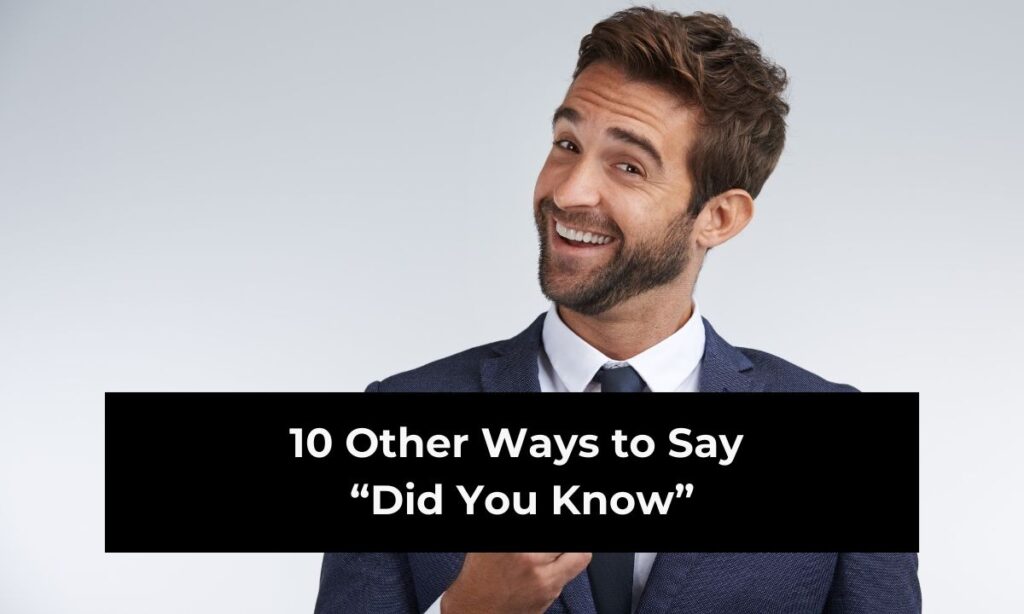You’ve probably used the phrase “Did you know” countless times—whether you’re sharing an interesting fact, sparking curiosity, or starting a fun conversation. It’s a simple phrase that works well, but let’s be honest: it can feel a little overused. If you want to keep your words engaging, creative, and memorable, finding alternatives can make all the difference.
Think about it. You might be writing a social media post, creating a presentation, teaching a class, or even texting a friend. Saying “Did you know” every time might start sounding repetitive. By switching up your phrasing, you not only grab attention but also set the tone for your message. Some alternatives feel more playful, while others sound more professional or dramatic.
Another reason to explore different ways of saying “Did you know” is the power of curiosity. Curiosity is what keeps people reading, listening, and engaging with what you share. When you use fresh and creative phrases, you instantly spark interest and encourage someone to stick around for more.

In this article, you’ll discover 10 unique and practical alternatives to “Did you know”. Each one comes with clear explanations, examples, and situations where you can use it effectively. Whether you want to sound conversational, academic, or intriguing, you’ll have the perfect phrase ready to go.
Must Read:
- Other Ways to Say “Stay Tuned”
- Other Ways to Say “Talk to You Soon”
- Other Ways to Say “As You Can See”
By the end, you’ll have a whole toolkit of expressions that make your writing and conversations feel natural, dynamic, and impactful. So, let’s dive into the different ways you can say “Did you know”—and why they work so well.
1. “Here’s Something Interesting”
When you want to grab someone’s attention without sounding too formal, “Here’s something interesting” is a perfect choice. It instantly sets the stage for curiosity, and the listener knows they’re about to learn something new.
This phrase works especially well in casual conversations, blog writing, or even teaching moments. Imagine sharing a fun fact at a dinner table: instead of saying “Did you know spiders can regrow legs?”, you can say, “Here’s something interesting: spiders can regrow legs.” It makes your tone more approachable and engaging.
Another advantage of this phrase is that it feels less like a question and more like an invitation. With “Did you know”, the other person might feel like they need to respond, even if they don’t. But “Here’s something interesting” lets you share freely while still drawing people in.
You can also use it in writing to create flow. For example, in an article or presentation, sprinkling this phrase helps keep the audience hooked. Think of it as a storytelling tool—it makes your information sound like a discovery rather than a lecture.
So, if you’re looking for a simple swap that feels warm and intriguing, this phrase will fit seamlessly into your communication.
2. “Fun Fact”
One of the most popular and lighthearted alternatives is “Fun fact.” This phrase has become a go-to way of sharing quirky, surprising, or little-known pieces of information. It works well when your goal is to keep the mood upbeat and conversational.
For example, you could say, “Fun fact: octopuses have three hearts.” It’s short, catchy, and guaranteed to make someone pause and pay attention. Unlike “Did you know”, which can sound a bit generic, “Fun fact” comes across as playful and modern.
The beauty of this phrase is its versatility. You’ll see it used in classrooms, team-building activities, marketing campaigns, and even casual conversations with friends. It naturally encourages curiosity without sounding forced. People almost expect something surprising to follow when they hear it.
It’s also perfect for written formats like newsletters, blog posts, or social captions. Because of its casual tone, it makes the audience feel like they’re in on a secret. It’s a quick way to turn ordinary information into something memorable.
So next time you’re about to share a piece of trivia or knowledge nugget, try leading with “Fun fact.” It’s short, sweet, and guaranteed to spark interest.
3. “Guess What”
If you want to build suspense before sharing information, “Guess what” is your best choice. It has an element of surprise and excitement built into it, which makes the listener curious even before you reveal anything.
Imagine saying, “Guess what: honey never spoils.” Instantly, the person you’re talking to feels like they’ve been pulled into a mini secret. It’s a great way to build anticipation, whether you’re telling a story, sharing news, or dropping an unusual fact.
This phrase works especially well in conversations where you want to be engaging and playful. Kids, for instance, respond really well to “Guess what” because it feels like a game. But it also works in adult conversations, adding a spark of personality to the way you share knowledge.
The only thing to keep in mind is that “Guess what” has a more casual vibe. It might not always fit in formal or academic settings, but in everyday conversations, it’s a winner.
Use it to keep your audience engaged, and you’ll find that people are more likely to remember what you shared—because the setup felt fun and unexpected.
4. “Here’s a Little Secret”
When you want to create a sense of exclusivity, “Here’s a little secret” works beautifully. It makes your audience feel like they’re getting insider knowledge, something not everyone knows.
For example, instead of saying “Did you know penguins propose with pebbles?”, you could say, “Here’s a little secret: penguins propose with pebbles.” Suddenly, the fact feels more personal and special.
This phrase works especially well in storytelling, content marketing, or even teaching. It gives your audience a sense of being part of something unique. People naturally enjoy feeling like they’re “in on” a secret, and this phrase taps into that emotion.
In written content, it adds a conversational and intimate tone. Readers feel like you’re whispering something directly to them, which makes your writing more engaging. In presentations, it can be a way to break monotony and recapture attention.
Use it sparingly, though. If you say “Here’s a little secret” too often, it can lose its magic. Save it for facts or insights that truly feel surprising, and it will leave a lasting impact.
5. “Have You Heard”
Another effective alternative is “Have you heard.” This phrase works well when you want to make information feel current or buzzworthy, almost like sharing the latest scoop.
For example, you might say, “Have you heard that sharks existed before trees?” The phrasing immediately positions the information as something fresh and worth knowing. It sounds conversational but also carries a sense of urgency, like you’re passing along important news.
This phrase is especially useful in social situations, classrooms, or even team meetings where you want to keep the tone lively. It creates the impression that the listener might be missing out on something, which motivates them to pay attention.
The beauty of “Have you heard” is that it works both in casual and semi-formal contexts. It’s not as playful as “Guess what”, but it’s not as plain as “Did you know.” It strikes a nice balance that makes it versatile for different settings.
Try using it when you want your audience to lean in and listen closely. It makes them feel like they’re part of a conversation rather than just receiving information.
6. “Here’s Something You Might Not Know”
If you’re looking for a phrase that combines curiosity with clarity, “Here’s something you might not know” is a great option. It immediately signals that what follows is new or uncommon information.
For instance, you could say, “Here’s something you might not know: bananas are berries, but strawberries aren’t.” It’s a direct yet intriguing way of presenting surprising facts.
This phrase works particularly well in educational or professional settings because it’s straightforward and respectful. Unlike “Guess what” or “Fun fact,” it avoids sounding too casual while still keeping a conversational tone.
It’s also excellent for long-form writing like articles, reports, or even speeches. It transitions smoothly into interesting insights without making your audience feel like you’re quizzing them.
The key advantage here is that it respects the audience’s intelligence. Instead of assuming they don’t know something, it simply offers the possibility that they might not. This small nuance makes the phrase sound friendly rather than condescending.
If you want a reliable, versatile alternative, this one should be at the top of your list.
7. “You Probably Didn’t Realize”
Sometimes you want to sound a little more dramatic, and “You probably didn’t realize” does exactly that. It sets up the information as something surprising, almost as if it’s hiding in plain sight.
For example, you might say, “You probably didn’t realize that the Eiffel Tower can grow taller in summer due to heat expansion.” This phrasing makes the fact feel extraordinary, even though it’s a simple piece of knowledge.
This phrase works beautifully in storytelling, persuasive writing, or presentations. It’s especially effective when you want to emphasize how overlooked or unexpected the fact is.
The tone here is a little bolder than some of the other alternatives. It challenges the listener in a friendly way, suggesting that the fact might catch them off guard. That small hint of drama can make your words more memorable.
Just like other options, it’s best used sparingly. Too much drama can feel forced. But when you drop this phrase at the right moment, it can leave your audience wide-eyed with curiosity.
8. “Let Me Share Something With You”
If you want to make your communication feel personal and direct, “Let me share something with you” is a perfect alternative. It creates an immediate connection with the listener and sets the tone for meaningful conversation.
For instance, you could say, “Let me share something with you: sea otters hold hands while they sleep so they don’t drift apart.” This way of phrasing feels warm, almost like you’re confiding in a friend.
This phrase is excellent for one-on-one conversations, presentations, or blog writing where you want to build trust with your audience. It doesn’t just deliver information—it feels like an exchange between two people.
Another benefit is that it works in both formal and casual contexts. In professional settings, it shows that you value the audience enough to share something with them directly. In casual settings, it simply makes the conversation more intimate.
If you’re aiming for warmth and connection in your message, this phrase is an excellent choice.
9. “It Might Surprise You to Learn”
When your goal is to highlight the surprising nature of information, “It might surprise you to learn” is a great way to set the stage. It tells the listener upfront that what’s coming is not ordinary.
For example, you could say, “It might surprise you to learn that sloths can hold their breath longer than dolphins.” Instantly, the audience knows they’re about to hear something unusual and worth remembering.
This phrase works well in both written and spoken formats. It’s professional enough for reports or educational contexts but still engaging for casual conversations. It creates anticipation without sounding too informal.
The strength of this phrase is that it highlights the emotional reaction of surprise. People are more likely to remember information when it shocks or amazes them, and this phrase prepares them for that reaction.
If you want your facts or insights to land with extra impact, this phrase will serve you well.
10. “Here’s Something Fascinating”
If you want to elevate your phrasing with a touch of sophistication, “Here’s something fascinating” is a great alternative. It sounds both professional and intriguing, making it versatile for almost any situation.
For example, you might say, “Here’s something fascinating: sharks existed before trees.” This phrasing sets the tone for wonder and intellectual curiosity, making the information feel important.
It works well in educational, professional, and even storytelling contexts. It’s slightly more polished than “Fun fact” or “Guess what,” which makes it suitable when you want to strike a balance between formal and engaging.
Another advantage is that it frames the information in a positive way. Calling something “fascinating” encourages your audience to view it with curiosity and appreciation. It primes them to be impressed before you even share the fact.
So, if you want a phrase that’s versatile, elegant, and impactful, this one will quickly become a favorite.
Conclusion
Using the same phrase over and over can make your communication feel repetitive. “Did you know” is effective, but it’s far from your only option. By experimenting with alternatives like “Fun fact,” “Guess what,” or “Here’s something fascinating,” you create variety and keep your audience engaged.
Each phrase carries its own personality. Some are playful and lighthearted, while others feel polished and professional. The key is to choose the one that best matches your tone, audience, and message. For example, if you’re writing a casual social caption, “Guess what” might be perfect. If you’re giving a professional presentation, “Here’s something you might not know” might be better.
Remember, curiosity is a powerful tool. By framing your facts and insights with fresh phrases, you invite people to lean in, pay attention, and remember what you’ve shared.
So, the next time you’re tempted to start with “Did you know,” pause for a moment. Pick one of these ten creative alternatives instead, and you’ll instantly make your communication more engaging, memorable, and fun.
FAQs
1. Why should I use alternatives to “Did you know”?
Because variety keeps your communication interesting. Repeating the same phrase can feel dull, while alternatives spark curiosity and engagement.
2. Which alternative works best in professional settings?
Phrases like “Here’s something fascinating” or “Here’s something you might not know” sound polished and are great for formal situations.
3. Can I use these phrases in writing as well as speaking?
Yes. These alternatives work beautifully in blog posts, articles, presentations, and everyday conversations.
4. What’s the most playful option?
“Fun fact” and “Guess what” are the most playful and casual choices, perfect for lighthearted contexts.
5. How do I choose the right phrase?
Think about your audience and your goal. If you want to sound fun, go for “Fun fact.” If you want to sound professional, choose “Here’s something fascinating.”





